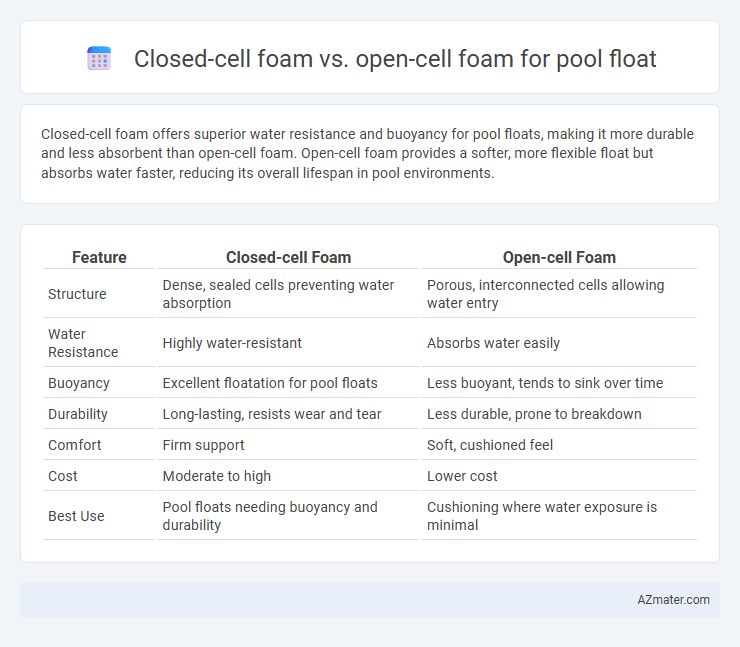Closed-cell foam offers superior water resistance and buoyancy for pool floats, making it more durable and less absorbent than open-cell foam. Open-cell foam provides a softer, more flexible float but absorbs water faster, reducing its overall lifespan in pool environments.
Table of Comparison
| Feature | Closed-cell Foam | Open-cell Foam |
|---|---|---|
| Structure | Dense, sealed cells preventing water absorption | Porous, interconnected cells allowing water entry |
| Water Resistance | Highly water-resistant | Absorbs water easily |
| Buoyancy | Excellent floatation for pool floats | Less buoyant, tends to sink over time |
| Durability | Long-lasting, resists wear and tear | Less durable, prone to breakdown |
| Comfort | Firm support | Soft, cushioned feel |
| Cost | Moderate to high | Lower cost |
| Best Use | Pool floats needing buoyancy and durability | Cushioning where water exposure is minimal |
Introduction to Pool Float Foam Types
Closed-cell foam offers superior water resistance and buoyancy, making it ideal for pool floats that require durability and long-lasting support. Open-cell foam is softer and more flexible, providing greater comfort but absorbing water more easily, which can reduce float time and increase weight. Understanding these key differences helps in selecting the right foam type based on comfort preferences and performance needs for pool float users.
What is Closed-Cell Foam?
Closed-cell foam consists of tightly packed cells that are completely sealed, preventing water absorption and providing superior buoyancy for pool floats. This type of foam offers excellent durability, resistance to compression, and enhanced insulation due to its dense structure. Closed-cell foam is ideal for pool floats that require long-lasting performance and increased stability on water surfaces.
What is Open-Cell Foam?
Open-cell foam consists of interconnected cells that create a spongy, flexible texture, allowing air and moisture to pass through easily. This porous structure offers superior cushioning but absorbs water, making it less ideal for pool floats that require buoyancy and water resistance. In contrast, closed-cell foam features sealed cells filled with gas, providing excellent flotation and durability against water absorption, essential qualities for effective pool float materials.
Buoyancy and Support Comparison
Closed-cell foam offers superior buoyancy due to its dense, water-resistant structure that prevents water absorption, making it ideal for pool floats requiring long-lasting support and stability. Open-cell foam, while softer and more comfortable, absorbs water more easily, reducing buoyancy over time and compromising support for extended use. The choice between closed-cell and open-cell foam directly impacts the float's ability to stay afloat and provide consistent support in aquatic environments.
Durability and Longevity
Closed-cell foam offers superior durability and longevity for pool floats due to its dense, impermeable structure that resists water absorption and physical damage. In contrast, open-cell foam tends to absorb water, leading to faster degradation, mold growth, and reduced lifespan. The closed-cell composition ensures consistent buoyancy and structural integrity over extended use, making it the preferred choice for durable pool floats.
Water Absorption and Resistance
Closed-cell foam for pool floats offers superior water resistance due to its dense, impermeable structure that prevents water absorption, ensuring the float remains buoyant and durable over time. Open-cell foam, with its porous and interconnected cells, absorbs water more easily, leading to increased weight, reduced buoyancy, and faster degradation. Choosing closed-cell foam enhances performance and longevity in aquatic environments by minimizing water retention and resisting mold or mildew growth.
Comfort and Flexibility
Closed-cell foam offers superior water resistance and buoyancy, ensuring stable support and lasting comfort for pool floats. Open-cell foam provides greater flexibility and softness, allowing it to conform more easily to the body for enhanced comfort but absorbs water more readily. Choosing between these foams depends on the balance needed between durability, comfort, and flexibility in pool float design.
Weight and Portability
Closed-cell foam is denser and lighter, making pool floats highly buoyant and easy to carry, ideal for portability during travel or storage. Open-cell foam absorbs water, increasing weight significantly and reducing portability, which may cause floats to feel heavier and less convenient to transport. Choosing closed-cell foam ensures a lightweight, durable pool float that maintains consistent buoyancy and ease of handling.
Cost Considerations
Closed-cell foam for pool floats generally costs more due to its dense structure and superior water resistance, making it a durable yet pricier option. Open-cell foam is less expensive because of its porous design, but it tends to absorb water, which can reduce buoyancy over time and lead to faster wear. Choosing closed-cell foam balances initial investment with long-term value, while open-cell foam suits budget-conscious buyers prioritizing upfront savings.
Which Foam Type is Best for Pool Floats?
Closed-cell foam is best for pool floats due to its high density, superior buoyancy, and resistance to water absorption, ensuring long-lasting flotation and durability. Open-cell foam, while softer and more flexible, absorbs water quickly, reducing buoyancy and causing faster degradation. Therefore, closed-cell foam remains the optimal choice for reliable, comfortable, and durable pool floats.

Infographic: Closed-cell foam vs Open-cell foam for Pool float
 azmater.com
azmater.com